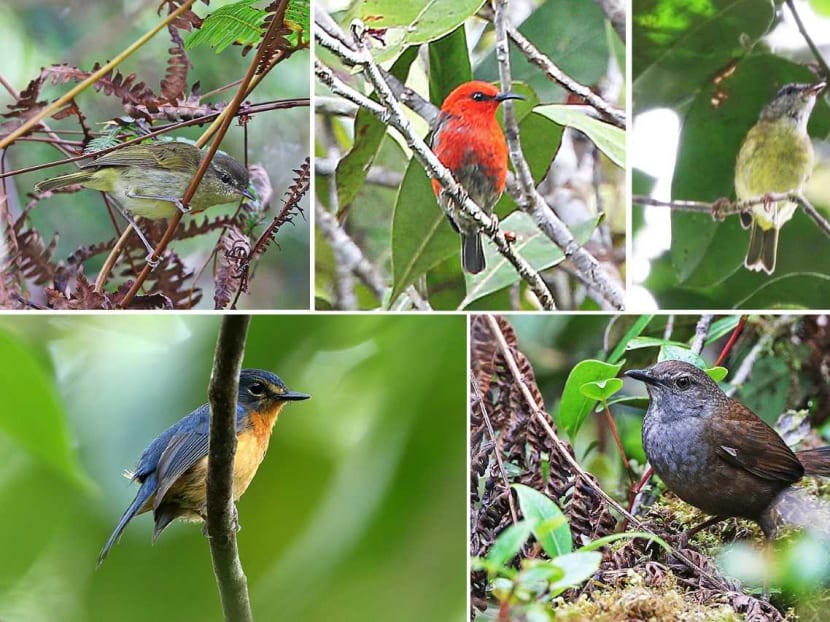‘Astounding discovery’: NUS researcher leads team which finds five new bird species in remote Indonesia
SINGAPORE — It was the cricket-like chirp of a bird that caught Associate Professor Frank Rheindt’s attention in the pouring rain about 1,050m up on a mountain on the island of Taliabu in north-east Indonesia in 2009.

NUS researcher Frank Rheindt led a team which found five new species and five new subspecies of birds in remote Indonesia. They included: (clockwise from top left) Taliabu Leaf-Warbler, Taliabu Myzomela, Peleng Leaf-Warbler, Taliabu Grasshopper-Warbler and Togian Jungle-Flycatcher.
SINGAPORE — It was the cricket-like chirp of a bird that caught Associate Professor Frank Rheindt’s attention in the pouring rain about 1,050m up on a mountain on the island of Taliabu in north-east Indonesia in 2009.
“I knew that it’s a general sound of a grasshopper warbler but the timing, the rhythm, and the frequency is quite different. So (I knew) it must be an undescribed species of grasshopper warbler,” said the German ornithologist, who is an associate professor at the National University of Singapore’s Department of Biological Sciences in the Faculty of Science.
It took two more ascents during that same trip for Assoc Prof Rheindt to spot the “shy” bird which he and his team later named the Taliabu Grasshopper-Warbler after an expedition between November 2013 and January 2014.
Assoc Prof Rheindt’s findings were published as a research paper on Friday (Jan 10) in the scientific journal “Science”. The research paper is co-authored with four other researchers from NUS who had helped to classify the birds as new species.
The six-week expedition was jointly conducted with three other researchers from the Indonesian Institute of Sciences, an Indonesian government agency for science and research.
During the expedition, the team also identified four other new species of birds: The Taliabu Myzomela, Taliabu Leaf-Warbler, Peleng Fantail and the Peleng Leaf-Warbler.
They also found five other subspecies of song birds, that is, birds that learn their song after birth, on Taliabu and its neighbouring islands of Peleng and Togian, which lie to the east of the island of Sulawesi.
Speaking to the media on Thursday, Assoc Prof Rheindt said that the discovery is significant as few new bird species are generally found compared to mammals or amphibians, for example.
“Most species have been described by now and it is astounding to see that there is still a place on earth where you can find five new species and five new subspecies within a relatively restricted area,” he said.
Since 1999, only five to six new bird species have been described on average each year. Assoc Prof Rheindt said that this is considerably less than for other animal groups.
“When you look at the discovery curve of birds, birds that are newly discovered or newly-described, perhaps in the new millennium it’s not rising, it’s steady. Whereas in all other animal groups it is steeply rising with no plateau in sight.”
Assoc Prof Rheindt said that he had chosen those specific Indonesian islands, which are deep-sea islands, to look for new species as the team wanted to find endemic species, or species that can be found nowhere else on earth.
Endemic species are more likely to occur in deep-sea islands that are surrounded by sea deeper than 120m. This means that during the ice age, the islands remained disconnected from other land masses. This made it difficult for animals to leave the island, ensuring that the species found there are unique.
Shallow islands with surrounding seas of up to 50m, on the other hand, form land bridges with other shallow islands during ice ages, allowing fauna of the different islands to interbreed. This reduces the occurrence of new species.
While there had been expeditions by other groups in the past, these had been limited to coastal areas, unlike the higher altitudes that Assoc Prof Rheindt and his team explored. The groups had been unable to penetrate the highlands of the interior at that time due to poor accessibility.
The most recent expedition to the islands was in 1991 by researchers from the East Anglia University. While they had seen some of the same birds that Assoc Prof Rheindt had, they did not recognise the birds as new species.
It was Assoc Prof Rheindt and his team from NUS which eventually verified that these birds were in fact, new species.
They did so by comparing the appearance, sounds and genes of the birds with other birds of similar species.
Looking ahead, Assoc Prof Rheindt hopes that identifying these birds will help conservation efforts as he believes that most of them are endangered due to habitat loss from forest fires in the last couple of decades.
Rising temperatures in the region may also make the current zones where the birds can be found uninhabitable.
“We need to be smart in our choices of how to invest our limited conservation resources to save some of the biodiversity out there and to do so we need to know where this biodiversity is or what their patterns of distribution are,” he said.
Assoc Prof Rheindt’s team also hoped to instil local pride and encourage conservation by naming one of the birds they discovered after a former president of Indonesia Bacharuddin Jusuf Habibie and another after Waahe, the village they stayed in during the expedition in Taliabu. These names are included in the Latin names of the birds.









